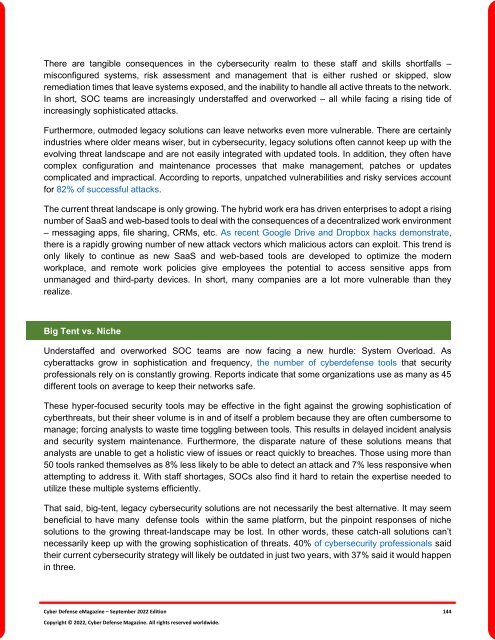Cyber Defense eMagazine September Edition for 2022 #CDM
#CYBERDEFENSEMAG @CyberDefenseMag by @Miliefsky a world-renowned cyber security expert and the Publisher of Cyber Defense Magazine as part of the Cyber Defense Media Group as well as Yan Ross, Editor-in-Chief and many more writers, partners and supporters who make this an awesome publication! Thank you all and to our readers! OSINT ROCKS! #CDM #CDMG #OSINT #CYBERSECURITY #INFOSEC #BEST #PRACTICES #TIPS #TECHNIQUES
#CYBERDEFENSEMAG @CyberDefenseMag by @Miliefsky a world-renowned cyber security expert and the Publisher of Cyber Defense Magazine as part of the Cyber Defense Media Group as well as Yan Ross, Editor-in-Chief and many more writers, partners and supporters who make this an awesome publication! Thank you all and to our readers! OSINT ROCKS! #CDM #CDMG #OSINT #CYBERSECURITY #INFOSEC #BEST #PRACTICES #TIPS #TECHNIQUES
You also want an ePaper? Increase the reach of your titles
YUMPU automatically turns print PDFs into web optimized ePapers that Google loves.
There are tangible consequences in the cybersecurity realm to these staff and skills shortfalls –<br />
misconfigured systems, risk assessment and management that is either rushed or skipped, slow<br />
remediation times that leave systems exposed, and the inability to handle all active threats to the network.<br />
In short, SOC teams are increasingly understaffed and overworked – all while facing a rising tide of<br />
increasingly sophisticated attacks.<br />
Furthermore, outmoded legacy solutions can leave networks even more vulnerable. There are certainly<br />
industries where older means wiser, but in cybersecurity, legacy solutions often cannot keep up with the<br />
evolving threat landscape and are not easily integrated with updated tools. In addition, they often have<br />
complex configuration and maintenance processes that make management, patches or updates<br />
complicated and impractical. According to reports, unpatched vulnerabilities and risky services account<br />
<strong>for</strong> 82% of successful attacks.<br />
The current threat landscape is only growing. The hybrid work era has driven enterprises to adopt a rising<br />
number of SaaS and web-based tools to deal with the consequences of a decentralized work environment<br />
– messaging apps, file sharing, CRMs, etc. As recent Google Drive and Dropbox hacks demonstrate,<br />
there is a rapidly growing number of new attack vectors which malicious actors can exploit. This trend is<br />
only likely to continue as new SaaS and web-based tools are developed to optimize the modern<br />
workplace, and remote work policies give employees the potential to access sensitive apps from<br />
unmanaged and third-party devices. In short, many companies are a lot more vulnerable than they<br />
realize.<br />
Big Tent vs. Niche<br />
Understaffed and overworked SOC teams are now facing a new hurdle: System Overload. As<br />
cyberattacks grow in sophistication and frequency, the number of cyberdefense tools that security<br />
professionals rely on is constantly growing. Reports indicate that some organizations use as many as 45<br />
different tools on average to keep their networks safe.<br />
These hyper-focused security tools may be effective in the fight against the growing sophistication of<br />
cyberthreats, but their sheer volume is in and of itself a problem because they are often cumbersome to<br />
manage; <strong>for</strong>cing analysts to waste time toggling between tools. This results in delayed incident analysis<br />
and security system maintenance. Furthermore, the disparate nature of these solutions means that<br />
analysts are unable to get a holistic view of issues or react quickly to breaches. Those using more than<br />
50 tools ranked themselves as 8% less likely to be able to detect an attack and 7% less responsive when<br />
attempting to address it. With staff shortages, SOCs also find it hard to retain the expertise needed to<br />
utilize these multiple systems efficiently.<br />
That said, big-tent, legacy cybersecurity solutions are not necessarily the best alternative. It may seem<br />
beneficial to have many defense tools within the same plat<strong>for</strong>m, but the pinpoint responses of niche<br />
solutions to the growing threat-landscape may be lost. In other words, these catch-all solutions can’t<br />
necessarily keep up with the growing sophistication of threats. 40% of cybersecurity professionals said<br />
their current cybersecurity strategy will likely be outdated in just two years, with 37% said it would happen<br />
in three.<br />
<strong>Cyber</strong> <strong>Defense</strong> <strong>eMagazine</strong> – <strong>September</strong> <strong>2022</strong> <strong>Edition</strong> 144<br />
Copyright © <strong>2022</strong>, <strong>Cyber</strong> <strong>Defense</strong> Magazine. All rights reserved worldwide.


















